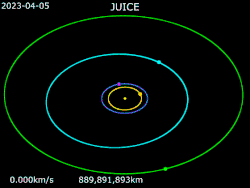| Discovery | |
|---|---|
| Discovered by | Johann Palisa |
| Discovery date | 9 March 1882 |
| Designations | |
| (223) Rosa | |
| A882 EA, 1887 BA 1942 EL | |
| Main belt (Themis) | |
| Orbital characteristics[1] | |
| Epoch 31 July 2016 (JD 2457600.5) | |
| Uncertainty parameter 0 | |
| Observation arc | 130.29 yr (47590 d) |
| Aphelion | 3.45415 AU (516.733 Gm) |
| Perihelion | 2.73689 AU (409.433 Gm) |
| 3.09552 AU (463.083 Gm) | |
| Eccentricity | 0.11586 |
| 5.45 yr (1989.3 d) | |
Average orbital speed | 16.94 km/s |
| 309.511° | |
| 0° 10m 51.488s / day | |
| Inclination | 1.93552° |
| 47.9276° | |
| 61.7716° | |
| Physical characteristics | |
Mean diameter | 82.7±8.4 km[2] |
| 20.283 h (0.8451 d) | |
| 0.0309±0.003 | |
| CP | |
| 9.68,[1] 9.72[3] | |
Rosa (minor planet designation: 223 Rosa) is a large Themistian asteroid. It is classified as a combination of C-type and P-type asteroids, so it is probably composed of carbonaceous material rich in water ice. It was discovered by Johann Palisa on 9 March 1882, in Vienna. The origin of the name is not known.
Photometric observations made in 2011–2012 at the Organ Mesa Observatory in Las Cruces, New Mexico, produced a light curve with a period of 20.283 ± 0.002 hours and a brightness variation of 0.13 ± 0.02 in magnitude. The curve has two asymmetrical maxima and minima per 20.283-hour cycle.[4]
The spacecraft JUICE is planned to pass through the asteroid belt twice, and a flyby of 223 Rosa has been proposed. If selected, JUICE would make its nearest approach on 15 October 2029.[2]

Sun · Earth · JUICE · Venus · 223 Rosa · Jupiter
References
- 1 2 Yeomans, Donald K., "223 Rosa", JPL Small-Body Database Browser, NASA Jet Propulsion Laboratory, retrieved 12 May 2016.
- 1 2 Avdellidou, C.; Pajola, M.; Lucchetti, A.; Agostini, L.; Delbo, M.; Mazzotta Epifani, E.; Bourdelle De Micas, J.; Devogèle, M.; Fornasier, S.; Van Belle, G.; Bruot, N.; Dotto, E.; Ieva, S.; Cremonese, G.; Palumbo, P. (2021). "Characterisation of the main belt asteroid (223) Rosa". Astronomy & Astrophysics. 656: L18. Bibcode:2021A&A...656L..18A. doi:10.1051/0004-6361/202142600. S2CID 244753425.
- ↑ Warner, Brian D. (December 2007), "Initial Results of a Dedicated H-G Project", The Minor Planet Bulletin, vol. 34, pp. 113–119, Bibcode:2007MPBu...34..113W.
- ↑ Pilcher, Frederick (July 2012), "Rotation Period Determinations for 46 Hestia, 223 Rosa, 225 Henrietta, 266 Aline, 750 Oskar, and 765 Mattiaca", The Minor Planet Bulletin, vol. 39, no. 3, pp. 171–173, Bibcode:2012MPBu...39..171P.
External links
- Lightcurve plot of 223 Rosa, Palmer Divide Observatory, B. D. Warner (2007)
- Asteroid Lightcurve Database (LCDB), query form (info Archived 16 December 2017 at the Wayback Machine)
- Dictionary of Minor Planet Names, Google books
- Asteroids and comets rotation curves, CdR – Observatoire de Genève, Raoul Behrend
- Discovery Circumstances: Numbered Minor Planets (1)-(5000) – Minor Planet Center
- 223 Rosa at AstDyS-2, Asteroids—Dynamic Site
- 223 Rosa at the JPL Small-Body Database